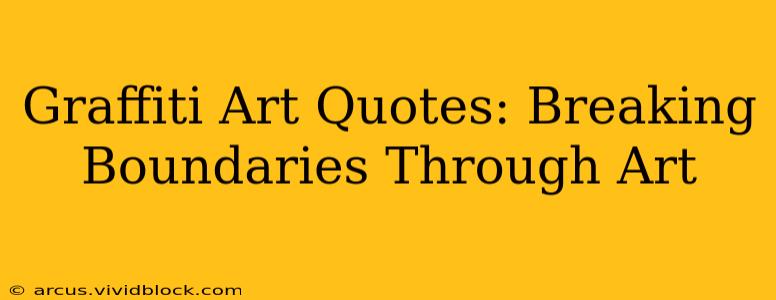Graffiti art, a vibrant and often controversial form of expression, has evolved from simple tagging to complex murals and installations. It's a powerful medium that challenges conventions, sparks dialogue, and pushes the boundaries of public space. This exploration delves into the world of graffiti art, examining its history, impact, and the powerful quotes that encapsulate its spirit. We'll also tackle some frequently asked questions surrounding this bold and captivating art form.
What is the meaning of graffiti art?
The meaning of graffiti art is multifaceted and highly dependent on the artist, their intentions, and the context of the piece. At its core, graffiti art is a form of visual communication, often expressing social commentary, personal experiences, or simply aesthetic beauty. It can be a rebellion against societal norms, a statement of identity, or a powerful form of self-expression in public spaces often denied to marginalized communities. The meaning is rarely singular; it's open to interpretation, sparking discussion and challenging viewers to engage with the artwork on multiple levels.
What are some famous graffiti art quotes?
While attributing specific quotes to graffiti artists can be challenging due to the anonymous nature of the art form, several quotes capture the essence of graffiti's spirit and philosophy:
- "A wall is a canvas, and the city is our gallery." This embodies the inherent rebelliousness of graffiti, transforming unexpected spaces into artistic displays.
- "Graffiti is the voice of the voiceless." This highlights the art form's ability to communicate messages that might otherwise be ignored or suppressed.
- "Art should comfort the disturbed and disturb the comfortable." This statement, while not specifically about graffiti, perfectly reflects its capacity to provoke thought and challenge preconceived notions.
Is graffiti art vandalism or art?
This is a central question surrounding graffiti art, often pitting legality against artistic expression. The line between vandalism and art is frequently blurred, dependent on factors such as location, permission, and the artwork's artistic merit. Many legal graffiti projects exist, showcasing the artistry within a sanctioned context. However, unauthorized graffiti on private property is undeniably vandalism. The debate highlights the complexities of defining art within societal norms and legal frameworks.
What are the different styles of graffiti art?
Graffiti encompasses a wide range of styles, each with its own unique characteristics:
- Tagging: The simplest form, consisting of stylized signatures or nicknames.
- Throwups: Quick, bold letterforms usually done with spray paint.
- Wildstyle: Intricate, interwoven letterforms that are difficult to decipher.
- Piece: Large-scale, elaborate murals that showcase advanced techniques.
- Stencils: Using cut-out templates to reproduce images quickly and repeatedly.
How has graffiti art evolved over time?
Graffiti art has dramatically evolved since its early forms, moving beyond simple tagging to embrace a wide array of styles and techniques. The rise of digital technology has influenced the art form, with artists employing computers and software in the design and execution of their pieces. Furthermore, the acceptance of graffiti as a legitimate art form has led to increased opportunities for artists to exhibit their work in galleries and museums.
What are the social and political impacts of graffiti art?
Graffiti art often serves as a potent tool for social and political commentary. It can raise awareness of important issues, critique social structures, and challenge authority. Artists utilize their work to express dissent, celebrate cultural identity, and promote social justice. The impact is multifaceted, ranging from inspiring dialogue to motivating social change.
Conclusion
Graffiti art, though often controversial, is a powerful and evolving art form that continues to push boundaries and challenge perceptions. Its history, techniques, and socio-political impact deserve careful consideration and appreciation. From simple tags to elaborate murals, graffiti art's enduring legacy lies in its ability to express, provoke, and inspire. The quotes that encapsulate this spirit underscore its lasting impact on our urban landscapes and collective consciousness.

